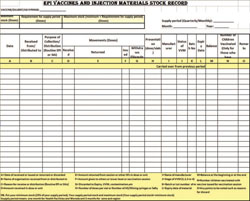Ordering vaccines
In the previous section you learnt how to estimate vaccine needs. Vaccines are very expensive, so it is important to ensure that the ordered vaccines will be used and not spoiled. The World Health Organization (WHO) recommends that every order for vaccines should take into account the considerations in Box 5.2. There are some new terms in this box which are explained below it.
Box 5.2 Considerations for vaccine ordering
Health facility staff should always use an EPI Vaccine and Injection Materials Stock Record (see Figure 5.5) to help them to:
- Avoid stock shortages, especially when mass immunization campaigns are planned.
- Avoid stock excesses, by not ordering excess stock, or exceeding the recommended storage periods.
- Avoid situations where vaccines expire during their storage period.
- Ensure that the other necessary stocks (e.g. diluents, syringes, needles; wick and paraffin or kerosene for refrigerators, etc.) are ordered at the same time as the vaccines.
- Organise stock using the principle of ‘bundling’ for all supplies required delivering an immunization session.
- Ensure that there are adequate cold chain storage facilities (both in capacity and temperature; see Study Session 6).

Bundling refers to the practise of organising related stock all together in ‘bundles’ consisting of the correct numbers of all the items you need during an immunization session:
- good quality vaccines and diluents
- auto-disable (AD) syringes (or single-use disposable syringes and needles, if these are still used)
- safety boxes, etc.
Auto-disable (AD) syringes were mentioned in Study Session 4, and are specially modified disposable syringes with a fixed needle; an AD syringe is automatically disabled after it has been used once, because the plunger cannot be pulled back a second time. The WHO recommends that immunization programmes use AD syringes for all vaccinations, to prevent re-use of contaminated injection equipment.
The cold chain is fully described in Study Session 6, and refers to the network of refrigerators, cold stores, freezers, cold boxes and vaccine carriers, and their efficient organisation and maintenance, so that vaccines are kept at the right temperature at all times. This ensures that vaccines keep their potency during their transportation and storage at all stages, from leaving the factory to the point of administration to the target population.
Storage of vaccines is a major challenge. Vaccines are easily damaged during storage if the cold chain is not maintained. Therefore it is important to divide the vaccine supply into manageable periods for the purpose of ordering stocks. A Health Post will usually have a shorter supply period (four weeks) than a health centre. The next section explains how to calculate the quantities of vaccine needed for a specific supply period.